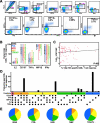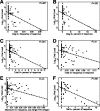HIV nonprogressors preferentially maintain highly functional HIV-specific CD8+ T cells
- PMID: 16467198
- PMCID: PMC1895811
- DOI: 10.1182/blood-2005-12-4818
HIV nonprogressors preferentially maintain highly functional HIV-specific CD8+ T cells
Abstract
Establishing a CD8(+) T cell-mediated immune correlate of protection in HIV disease is crucial to the development of vaccines designed to generate cell-mediated immunity. Historically, neither the quantity nor breadth of the HIV-specific CD8(+) T-cell response has correlated conclusively with protection. Here, we assess the quality of the HIV-specific CD8(+) T-cell response by measuring 5 CD8(+) T-cell functions (degranulation, IFN-gamma, MIP-1beta, TNF-alpha, and IL-2) simultaneously in chronically HIV-infected individuals and elite nonprogressors. We find that the functional profile of HIV-specific CD8(+) T cells in progressors is limited compared to that of nonprogressors, who consistently maintain highly functional CD8(+) T cells. This limited functionality is independent of HLA type and T-cell memory phenotype, is HIV-specific rather than generalized, and is not effectively restored by therapeutic intervention. Whereas the total HIV-specific CD8(+) T-cell frequency did not correlate with viral load, the frequency and proportion of the HIV-specific T-cell response with highest functionality inversely correlated with viral load in the progressors. Thus, rather than quantity or phenotype, the quality of the CD8(+) T-cell functional response serves as an immune correlate of HIV disease progression and a potential qualifying factor for evaluation of HIV vaccine efficacy.
Figures




References
-
- Schmitz JE, Kuroda MJ, Santra S, et al. Control of viremia in simian immunodeficiency virus infection by CD8+ lymphocytes. Science. 1999;283: 857-860. - PubMed
-
- Goulder PJR, Phillips RE, Colbert RA, et al. Late escape from an immunodominant cytotoxic T lymphocytes response associated with progression to AIDS. Nat Med. 1997;3: 212-217. - PubMed
Publication types
MeSH terms
Substances
Grants and funding
LinkOut - more resources
Full Text Sources
Other Literature Sources
Medical
Research Materials

